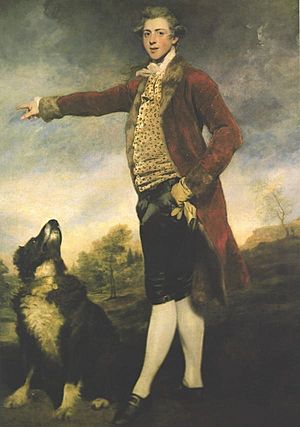John Campbell, 1st Baron Cawdor facts for kids
Quick facts for kids
The Lord Cawdor
|
|
|---|---|

Portrait by Sir Joshua Reynolds
|
|
| Member of Parliament for Cardigan Boroughs | |
| In office 1780–1796 |
|
| Member of Parliament for Nairnshire | |
| In office 1777–1780 |
|
| Personal details | |
| Born | 1753 Wales |
| Died | 1 June 1821 (aged 68) Bath, Somerset, UK |
| Resting place | Bath Abbey |
| Political party | Pittite (from 1783) |
| Other political affiliations |
Whig (until 1783) |
| Spouse | Isabella Caroline Howard |
| Children | 2 |
| Education | Eton College |
| Alma mater | Clare College, Cambridge |
John Campbell, 1st Baron Cawdor, was an important Welsh politician and a keen art collector. He lived from about 1753 to 1821. He was a member of the House of Commons, which is part of the British Parliament, for many years. He was also a Fellow of the Royal Society (FRS) and a Fellow of the Society of Antiquaries (FSA).
Contents
Early Life and Education
John Campbell was born around 1753. His father was Pryse Campbell, and his mother was Sarah Bacon. He had four siblings: Sarah, George, Alexander, and Charles.
He attended Eton College, a famous boarding school, from 1763 to 1767. After that, he went on to study at Clare College, Cambridge in 1772.
Inheriting Wealth
John's father passed away in 1768. Then, in 1777, his grandfather died. This meant John inherited a lot of property and money.
He received Stackpole Estate in Pembrokeshire, Wales. He also inherited other estates in Pembrokeshire and Nairn, Scotland. A very important part of his inheritance was a mining estate in Cardiganshire. These lands and mines made him a very rich man.
Political Career
John Campbell began his political career as a Member of Parliament (MP). An MP is a person elected to represent a group of people in the House of Commons.
From 1777 to 1780, he represented Nairnshire in Scotland. In June 1780, he became the MP for Cardigan Boroughs in Wales. He held this seat until 1796.
Governor and Lord
From 1780, John Campbell also served as the Governor of Milford Haven. This was an important role in managing the port.
He started his political life as a Whig. He supported Lord North, a leading politician at the time. Campbell was a strong supporter of ending the slave trade. He later changed his political views and supported William Pitt the Younger's war policies.
In 1796, he left the House of Commons. He was then given a new title: Baron Cawdor of Castlemartin. This meant he became a member of the House of Lords.
Art Collection and Interests
Between 1783 and 1788, John Campbell traveled to Italy and Sicily. He was very interested in art and ancient history.
He bought many old artifacts, known as antiquities, from various dealers. He also asked artists to paint pictures of ancient sites in Naples and Sicily. He even bought sculptures from the famous artist Canova, though he never actually received them.
Famous Purchases
In 1788, Campbell bought the famous Lante Vase. This vase is now located at Woburn Abbey. He also started collecting ancient Greek vases from southern Italy.
He continued to add to his collection, including architectural pieces and casts of sculptures. He created a special museum in his London home. This museum was designed to teach about art history. The sculptor John Flaxman praised it as "excellent news for the arts."
In 1794, he became a Fellow of the Society of Antiquaries. The next year, in 1795, he became a Fellow of the Royal Society. These were important honors for his contributions to knowledge.
Military Role
In 1797, John Campbell played a key role in defending Britain. He was the commander of the Pembrokeshire Yeomanry. This was a local volunteer army.
His troops famously defeated Napoleon's soldiers during the Last invasion of Britain. This was the last time a hostile foreign force landed on British soil. The following year, he was made a Colonel in the Carmarthenshire Militia.
Later Life and Family
As a landowner, John Campbell worked to improve his estates. He drained marshy land and created lakes. He was also known for being very generous to people who were poor.
In 1800, he sold the items from his museum. Some pieces were bought by the architect Sir John Soane. In 1804, he inherited even more land from John Vaughan, adding to his large property holdings. In 1808, he served as the Mayor of Carmarthen.
Lord Cawdor passed away on June 1, 1821, in Bath. He was buried at Bath Abbey.
Marriage and Children
On July 28, 1789, he married Lady Isabella Caroline Howard. She was the daughter of Frederick Howard, the 5th Earl of Carlisle.
They had two children together:
- John Frederick Campbell, 1st Earl Cawdor (1790–1860). He married Elizabeth Thynne.
- Rear-Admiral Hon. George Pryse Campbell (1793–1858). He married Charlotte Gascoyne in 1821.
Portraits
A portrait of John Campbell was painted by the famous artist Joshua Reynolds in 1778. This painting is now at Cawdor Castle. A smaller portrait, called a miniature, was made by Richard Cosway. This miniature is kept in the National Galleries of Scotland.

